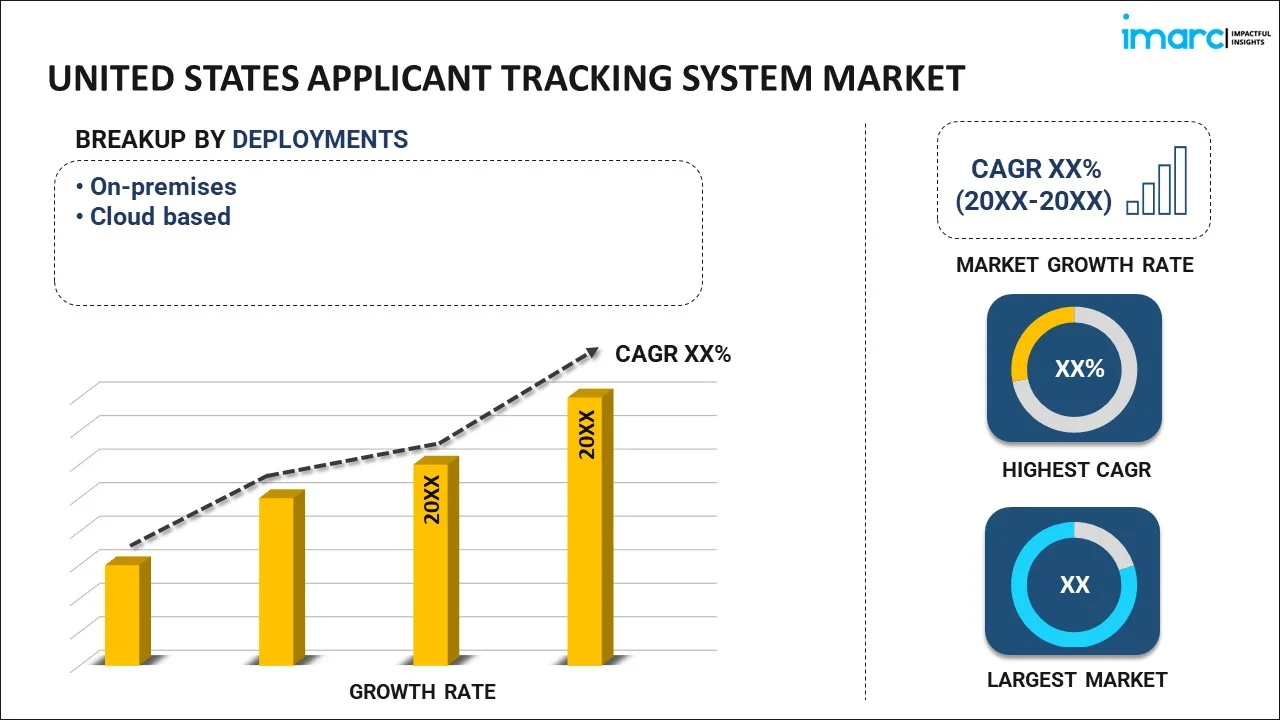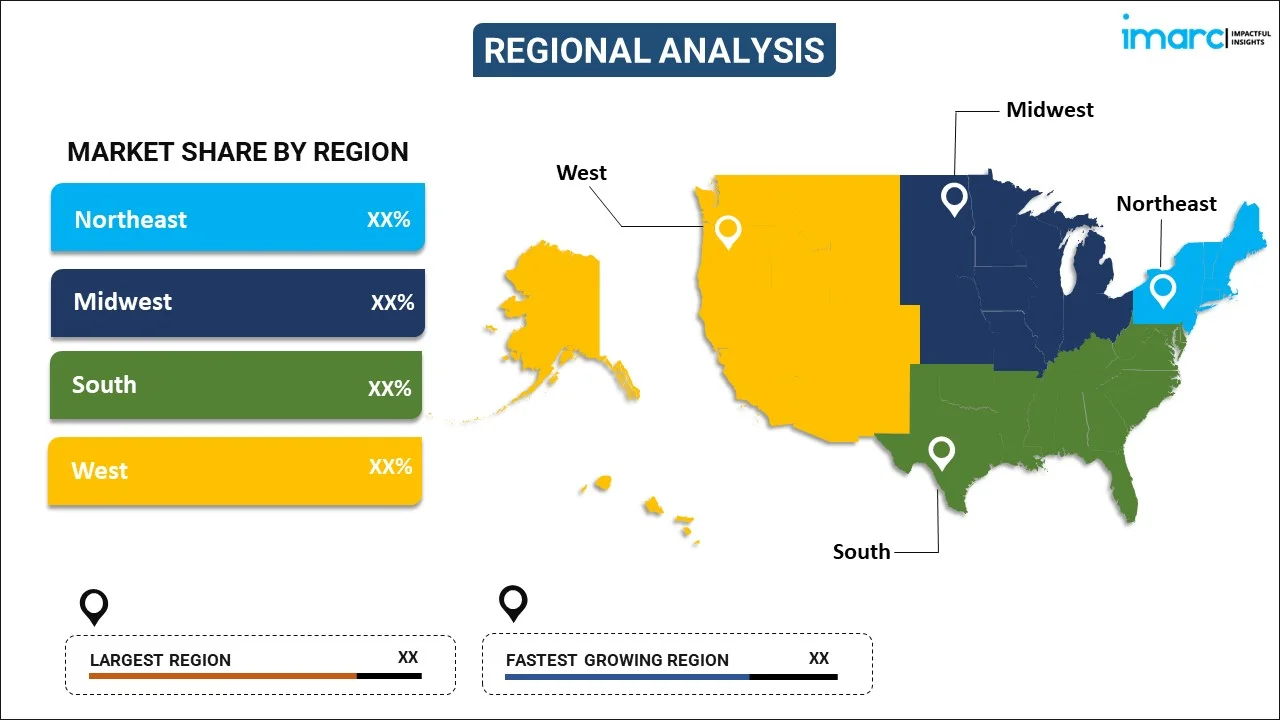
United States Applicant Tracking System Market Report by Deployment (On-premises, Cloud based), Organization Size (Small and Medium-sized Enterprises, Large Enterprises), Component (Software, Services), End User (BFSI, IT and Telecommunications, Government and Public Sector, Retail, Manufacturing, Healthcare and Life Sciences, and Others), and Region 2025-2033
Market Overview:
United States applicant tracking system market size reached USD 980.20 Million in 2024. Looking forward, IMARC Group expects the market to reach USD 2,146.53 Million by 2033, exhibiting a growth rate (CAGR) of 8.60% during 2025-2033. The widespread adoption of cloud-based platforms, along with the growing focus among organizations for managing the hiring process of suitable candidates, is primarily driving the market growth.
|
Report Attribute
|
Key Statistics
|
|---|---|
|
Base Year
|
2024
|
|
Forecast Years
|
2025-2033
|
|
Historical Years
|
2019-2024
|
|
Market Size in 2024
|
USD 980.20 Million |
|
Market Forecast in 2033
|
USD 2,146.53 Million |
| Market Growth Rate 2025-2033 | 8.60% |
United States Applicant Tracking System Market Analysis:
- Major Market Drivers: The market is influenced by increasing demand for automated recruitment, data-driven hiring practices, and automation of talent acquisition workflows across industries looking for enhanced recruitment efficiency and decreased time-to-fill metrics, propelling United States applicant tracking system market share.
- Key Market Trends: Artificial intelligence (AI)-driven resume filtering, human resources (HR) software ecosystem integration, candidate experiences optimized for mobile, and the increased application of analytics to workforce planning and diversity hiring campaigns within the United States applicant tracking system market.
- Competitive Landscape: The market is dominated by the coexistence of mature enterprise platforms and upstart SaaS providers with customizable, scalable, and vertical-focused solutions, fueling competition by means of innovation, user experience, and value-added service differentiation.
- Challenges and Opportunities: Challenges are data privacy issues, integration issues, and resistance to user adoption. Opportunities, though, are cloud-native platforms, small business adoption, and AI feature development driving candidate engagement and compliance with developing U.S. employment laws.
An applicant tracking system (ATS) is a software for talent management that systematically organizes and oversees an organization's job openings, resumes, candidates, and client information. The software's database simplifies the hiring process by conducting initial analysis and filtering out qualified candidates for a position. Through the applicant tracking system, managers can efficiently schedule interviews, send rejection letters, and manage necessary paperwork digitally. The primary objective is to alleviate the workload on recruiters while establishing a centralized repository for candidate information. Additionally, the applicant tracking system contributes to reducing the time spent on administrative tasks, expediting resume screening, and promoting collaborative recruitment, ultimately enhancing the overall candidate experience.
United States Applicant Tracking System Market Trends:
AI-Driven Automation and Intelligent Screening
The use of artificial intelligence (AI) in applicant tracking systems is revolutionizing recruitment operations nationwide in the United States. AI-based tools are increasingly being employed to automate resume screening, rank potential hires on parameters defined in advance, and identify top talent using predictive analytics. As per the sources, in May 2025, CareConnect has announced the forthcoming addition of its Home Health Care Hire ATS within the ADP Marketplace, connecting with myCNAjobs to streamline caregiver hiring and drive 24% increase in 90-day retention. Moreover, AI minimizes human intervention at initial screening stages, making decision-making more accurate, accelerating hiring cycles, and reducing biases. Natural language processing (NLP) and machine learning (ML) algorithms are being used more frequently to review applicant answers and job candidate behavioral patterns, enhancing candidate-fit alignment with job specifications. This emphasizes the growing pressure on efficiency and fact-based hiring, especially for big businesses with high application volumes. The growth of AI adoption will continue to move even higher, leading to significant recruiter productivity gains. This technological advancement is one of the primary drivers of United States applicant tracking system market growth and represents a critical trend of the market analysis.
Integration with the Wider HR Ecosystems
One of the key trends on the United States applicant tracking system scene is the tight integration of ATS software with the wider human resource management systems (HRMS), payroll software, and onboarding solutions. Firms are giving top priority to interoperability and real-time exchange of data to automate the end-to-end hiring and employee lifecycle management processes. Seamlessly integrated platforms allow recruiters and HR managers to oversee all the way from job advertisements to employee performance monitoring under an integrated digital platform. This integration removes duplications, improves the accuracy of data, and facilitates end-to-end workforce planning. Integration with third-party job boards, assessment providers, and communication platforms also boosts candidate engagement and sourcing features. This systemic approach is most beneficial to mid-sized to large businesses seeking to scale operations optimally. The movement toward system integration is a major driving factor in United States applicant tracking system market demand, and it ensures that hiring processes are both scalable and aligned strategically with general business goals.
Candidate Experience and Engagement Focus
Improving the candidate experience ranks as the number one concern among the development of applicant tracking systems in the United States. Contemporary ATS technology is more likely to include innovations that make the application process more personal, such as real-time application status, mobile-friendly websites, and AI chatbots for instant assistance of candidate inquiries. These functionalities enable greater transparency, minimize drop-off points, and enhance employer brand reputation. Candidate interaction is also the focus of attention in post-application communication, such as automated scheduling, personalized feedback, and streamlined onboarding workflows. In tight labor markets, a responsive and positive candidate experience can play a critical role in enabling an organization to attract and retain top performers. This movement represents a larger realignment away from process-based systems and towards people-first platforms. The increasing significance of user experience is today a hallmark characteristic of market share, an essential factor in current United States applicant tracking system market analysis.
United States Applicant Tracking System Market Segmentation:
IMARC Group provides an analysis of the key trends in each segment of the market, along with forecasts at the country level for 2025-2033. Our report has categorized the market based on deployment, organization size, component, and end user.
Deployment Insights:

To get more information on this market, Request Sample
- On-premises
- Cloud based
The report has provided a detailed breakup and analysis of the market based on the deployment. This includes on-premises and cloud based.
Organization Size Insights:
- Small and Medium-sized Enterprises
- Large Enterprises
A detailed breakup and analysis of the market based on organization size have also been provided in the report. This includes small and medium-sized enterprises and large enterprises.
Component Insights:
- Software
- Services
The report has provided a detailed breakup and analysis of the market based on the component. This includes software and services.
End User Insights:
- BFSI
- IT and Telecommunications
- Government and Public Sector
- Retail
- Manufacturing
- Healthcare and Life Sciences
- Others
A detailed breakup and analysis of the market based on end user have also been provided in the report. This includes BFSI, IT and telecommunications, government and public sector, retail, manufacturing, healthcare and life sciences, and others.
Regional Insights:

- Northeast
- Midwest
- South
- West
The report has also provided a comprehensive analysis of all the major regional markets, which include the Northeast, Midwest, South, and West.
Competitive Landscape:
The market research report has also provided a comprehensive analysis of the competitive landscape in the market. Competitive analysis such as market structure, key player positioning, top winning strategies, competitive dashboard, and company evaluation quadrant has been covered in the report. Also, detailed profiles of all major companies have been provided.
Latest News and Developments:
- In June 2025, SmartRecruiters unveiled its AI-driven hiring platform with Winston, an agentic AI that is transforming talent acquisition. Bypassing legacy ATS technology, the platform provides real-time automation, adaptive candidate experience, and enterprise-level scale, representing a paradigm shift in how global organizations attract, evaluate, and hire talent.
- In February 2025, Barrett Business Services (BBSI) launched its integrated Applicant Tracking System (ATS), enhancing hiring efficiency for U.S. businesses. The platform enables job posting, centralized candidate tracking, and electronic onboarding, fully integrated with BBSI’s payroll system to reduce manual entry and streamline transitions from candidate to employee.
- In March 2024, Bullhorn released Copilot, an AI-powered feature that is part of its applicant tracking system in the United States. Built to streamline routine recruitment processes, enhance candidate experience, and increase recruiter effectiveness, Copilot represents a major breakthrough in applicant tracking technology in the U.S. staffing industry.
United States Applicant Tracking System Market Report Coverage:
| Report Features | Details |
|---|---|
| Base Year of the Analysis | 2024 |
| Historical Period | 2019-2024 |
| Forecast Period | 2025-2033 |
| Units | Million USD |
| Scope of the Report | Exploration of Historical and Forecast Trends, Industry Catalysts and Challenges, Segment-Wise Historical and Predictive Market Assessment:
|
| Deployments Covered | On-premises, Cloud based |
| Organization Sizes Covered | Small and Medium-sized Enterprises, Large Enterprises |
| Components Covered | Software, Services |
| End Users Covered | BFSI, IT and Telecommunications, Government and Public Sector, Retail, Manufacturing, Healthcare and Life Sciences, Others |
| Regions Covered | Northeast, Midwest, South, West |
| Customization Scope | 10% Free Customization |
| Post-Sale Analyst Support | 10-12 Weeks |
| Delivery Format | PDF and Excel through Email (We can also provide the editable version of the report in PPT/Word format on special request) |
Key Benefits for Stakeholders:
- IMARC’s industry report offers a comprehensive quantitative analysis of various market segments, historical and current market trends, market forecasts, and dynamics of the United States applicant tracking system market from 2019-2033.
- The research report provides the latest information on the market drivers, challenges, and opportunities in the United States applicant tracking system market.
- Porter's five forces analysis assist stakeholders in assessing the impact of new entrants, competitive rivalry, supplier power, buyer power, and the threat of substitution. It helps stakeholders to analyze the level of competition within the United States applicant tracking system industry and its attractiveness.
- Competitive landscape allows stakeholders to understand their competitive environment and provides an insight into the current positions of key players in the market.
Key Questions Answered in This Report
The applicant tracking system market in the United States was valued at USD 980.20 Million in 2024.
The United States applicant tracking system market is projected to exhibit a (CAGR) of 8.60% during 2025-2033, reaching a value of USD 2,146.53 Million by 2033.
Key drivers of the United States applicant tracking system market are the increasing demand for automation within recruitment processes, decreasing time-to-hire and cost-per-hire, and enhancing compliance. Further, expanding integration with HR software, data-driven hiring insights, and focus on improving the candidate experience are driving adoption among enterprises, especially in competitive and high-volume hiring scenarios.
Need more help?
- Speak to our experienced analysts for insights on the current market scenarios.
- Include additional segments and countries to customize the report as per your requirement.
- Gain an unparalleled competitive advantage in your domain by understanding how to utilize the report and positively impacting your operations and revenue.
- For further assistance, please connect with our analysts.
 Request Customization
Request Customization
 Speak to an Analyst
Speak to an Analyst
 Request Brochure
Request Brochure
 Inquire Before Buying
Inquire Before Buying




.webp)




.webp)












